| Published
on 24
Mar
2012 |
All rights reserved.
|
|
|
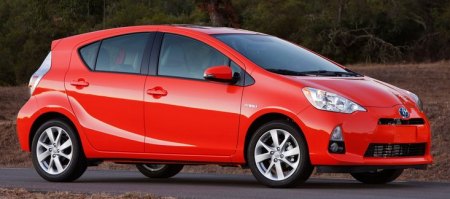
Prius is a miracle. With
nearly half a million units sold a year it is by far the biggest
selling hybrid car in the world. Probably the most profitable model in
Toyota's lineup, too. Apart from Prius, Toyota developed many other
hybrids, including Sai (Lexus HS250h), Lexus CT200h, Camry Hybrid,
Crown Hybrid, Highlander Hybrid, Lexus GS450h, LS600h, RX450h, Auris
HSD… too many to remember. However, none quite matches half the success
of Prius. To get an annual sales volume of 250,000 units or more you
need not another niche but a bread-and-butter hybrid. As Prius had
already occupied the heartland, the next logical step will be the
smaller compact car segment. Aqua is the one to take on this mission.
The Aqua is not the first of its kind – that should be Honda Insight. Introduced
3 years ago, the Insight attempted to lower the entry point of hybrid
ownership by offering a smaller and cheaper package. Unfortunately, its
fundamentally flawed IMA hybrid system failed to deliver the kind of
fuel efficiency that people expect. As a result, its sales never quite
took off.
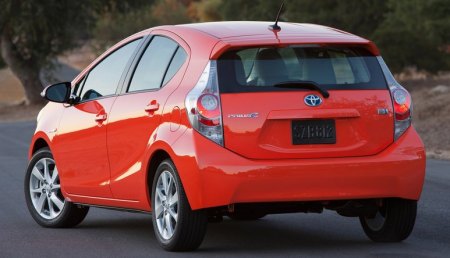
The Aqua is not going to face the same criticisms, because it employs
Toyota's Hybrid Synergy Drive (HSD). With two motors, one dedicated to
propulsion and another optimized for generation, its efficiency should
be much higher than the single-motor system of Honda. Moreover, the
propulsion motor in Toyota is much more powerful than Honda's thin-disc
motor (61 vs 13.6 hp), thus its electric power is available across a
wider speed and load range. This mean the Aqua can run in EV mode more
of the time and save fuel, especially in urban area. According to US
EPA rating, the Aqua returns 53 mpg in city and 46 mpg on highway,
overshadowing its rival's 41 and 44 mpg respectively.
To take advantage of the established image of Prius, the Aqua is named
as Prius C – where C stands for City – in North America. We may need
more time to see how successful it will be over there, but sales
figures in Japan are already encouraging. In February, the second full
month since it went on sale in Japan, it sold some 22,000 units,
trailing only Prius and Honda Fit (Jazz) in the domestic sales chart.
If the trend continues, by the end of this year more than 250,000 Aquas
will be sold at its home market. In addition to the demand from
American buyers, the Iwate plant in Japan is almost certain to reach
its maximum volume of 360,000 units/year on 3 shifts.
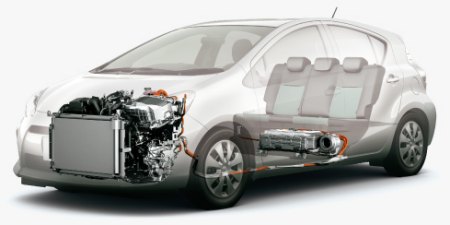
The Aqua is built on the Yaris / Vitz platform. We classify it as
B-segment, a class smaller than the C-segment Insight because it is
some 400 mm shorter. However, its wheelbase and width are actually
identical to Honda's, while its roof stands 20 mm taller. Therefore its
cabin is roomy. EPA measurement shows its front occupants get much the
same space as the Honda, while rear passengers enjoy 50 mm more legroom
and 15 mm more headroom. Trunk space also eclipses the Insight's by
17.1 vs 15.9 cubic feet.
The hybrid system is similar to Prius, just being smaller in every way
to take advantage of the car's 215 kg lighter kerb weight – at 1165 kg the car is
featherweight by the standard of hybrid vehicles. The Atkinson-cycle
four-cylinder engine has shrunk to 1.5 liters, producing only 74
horsepower. The electric motor is smaller too, producing 61 hp instead
of 80 hp. The NiMH battery pack, sitting under the rear seats, is made
of 120 cells instead of 168 cells, and have a capacity of 0.87 kWh
instead of 1.3 kWh. These measures cut significant costs.
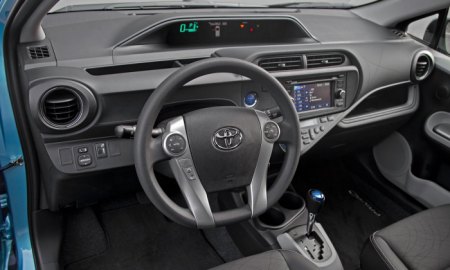
Equally cost-cutting is the interior, which features a hard plastic
dashboard and simpler instruments. The 3.5-inch LCD is no larger than
your iPhone's. To enable a reasonable price it has to sacrifice the
expensive build quality and features that you normally expect on
conventional cars.
On the road, the Aqua drives pretty much like a hybridized Yaris –
that's what we can expect from the forthcoming Yaris HSD. Its body
control is surprisingly good as the suspension setting is quite firm.
On the flipside, ride comfort suffers on poor surfaces. Steering feel
is as numb as its platform donor. Highway refinement might be helped by
the teardrop shape (Cd is only 0.28), but the chassis is clearly tuned
for urban drive thus high-speed stability is lacking. You won't buy the
Aqua for driving fun.
The hybrid powertrain works just as expected. It offers decent
performance with the help of electric motor, but it hates to be
hurried. The rubberband effect of CVT leads to a delay between throttle
application and actual acceleration, hence a sense of sluggish throttle
response. This lack of go is made even stranger as the engine is
screaming noisily at the same time. The regenerative braking is well
sorted in this car, with a firm pedal. The throttle pedal is not as
good, as its short range of travel makes it difficult to modulate.
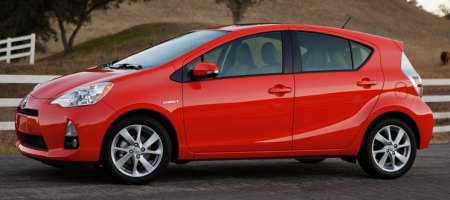
All these mean
the Aqua or Prius C is not going to be our choice. However, as a green
city car it is still worth considering. More so than Honda Insight it
combines the practicality and affordability of conventional family
hatches with real gain in fuel economy. The lower running costs and tax
breaks should make it appealing to many people demanding a private
urban transport.
|
Verdict:    |
|